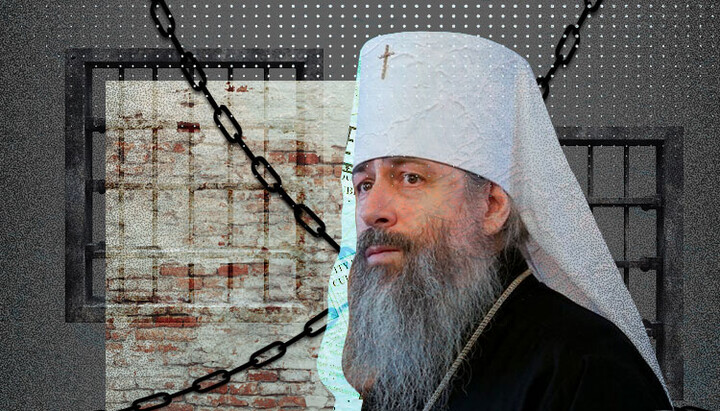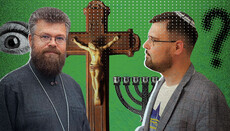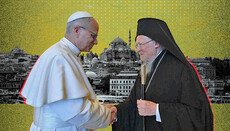The Metropolitan Arseniy case: A release that became a new captivity

The authorities “released” the metropolitan only to throw him back behind bars again.
On October 23, 2025, the Dnipro Court of Appeal made a decision awaited by millions of believers: Metropolitan Arseniy, abbot of the Sviatohirsk Lavra, was released from custody on bail. For a brief moment, those who had been praying for him felt that their pastor could finally breathe again. But very soon it became clear – that hope was false.
The judges ruled to release the metropolitan on bail of 1,514,000 hryvnias. They hesitated for a long time before announcing the verdict, but the hierarch’s health was so poor that even representatives of the Ukrainian Themis understood he might die in prison. Those who gathered the money for bail did so not out of politics but out of love: for them, Metropolitan Arseniy is a father, a man of prayer, the one who raised the Sviatohirsk Lavra from ruins. On Monday, October 27, they deposited the full amount as required by law.
Yet the next day, October 28, at 16:59, even before the detention center had formally received the paperwork confirming payment, Metropolitan Arseniy stepped out of his cell – only to be surrounded at once by SBU officers.
He had no money, no phone, and no escort from his monastery. The first thing he saw after weeks in a prison cell was once again a government car and SBU agents who drove him to an investigator of the SBU’s Second Department for Donetsk and Luhansk regions. Thus ended his “freedom,” which lasted less than a minute.
The SBU justified the new arrest by claiming that “the suspect might flee.” The words sounded grotesque. Metropolitan Arseniy – the man doctors urged to undergo heart surgery, who can barely move – might flee? Moreover, he had never given the slightest reason for such suspicion. Not because he feared human judgment, but because he lived by Christ’s words: “The good shepherd lays down his life for the sheep” (John 10:11). Perhaps that very faithfulness enrages the Church’s persecutors most. For they cannot comprehend that if a monk wishes to “flee” anywhere, it is only to his monastery – for he already fled the world on the day of his tonsure.
A lawyer from the state legal aid center was present but powerless to help. When Metropolitan Arseniy’s actual attorneys learned what had happened, they rushed to the SBU office, demanding his release as the detention was unlawful. The investigator refused – clearly obeying an order. Without trial, without proof, the hierarch was again made a prisoner.
From evening until midnight, he remained in SBU custody. Then came the next act in this drama of humiliation.
At midnight he was taken to the Dnipro emergency hospital. The cardiologist glanced at the recommendations for urgent heart surgery and dismissed them without examination. Without even questioning the patient, she measured his pressure “on the go” and declared: hospitalization unnecessary.
Then came a psychiatric check – alcohol, drugs, the usual procedure, though this time it had the tone of mockery. After that, he was driven through the night to the Dnipro pretrial detention facility No. 1.
At the gates, a long queue of detainees had formed. For an hour and a half, the bishop sat in the car, forbidden to step out. Around three in the morning he was finally brought inside. Another hour passed on paperwork. Only at four a.m. did Metropolitan Arseniy find himself in a cell. One can only imagine what he endured – nearly twelve hours on his feet, in the dead of night, a man with severe heart problems. Thus ended his first day “in freedom.”
On October 29, the Shevchenkivskyi District Court was to hear his lawyers’ complaints about the unlawful detention. At the time of writing, the outcome is unknown. Meanwhile, the Sobornyi District Court is preparing to choose new preventive measures under Article 436-2 of the Criminal Code – “justification of Russian aggression.” The prosecution demands that he remain in custody. The date of that hearing is also unknown.
What is known is the logic of the repressive machine: the weaker his body becomes, the more cases are opened against him – for one purpose only, to break him. If not spiritually, then physically.
On September 30, the bishop had already been hospitalized; doctors then insisted on heart surgery. Yet now, a month later, he spends sleepless nights under interrogation, endures humiliation and queues at detention gates – all under fabricated accusations. Few doubt that all this suffering is the price of his faithfulness to the Church.
“If they persecuted Me, they will also persecute you” (John 15:20).
These words of Christ sound literal today. What happens to Metropolitan Arseniy is the Gospel spoken anew. This is not merely a political case. It is a war against the Church itself – an attempt to force her to her knees.
The new 1930s: Church and power, a century later
Reading the Church chronicles of recent years feels like déjà vu. A hundred years ago, in the 1920s, priests, monks, and laity were interrogated in Kyiv, Kharkiv, and Odesa. The charges were familiar: “counterrevolutionary activity,” “links with the enemy,” “spreading hostile ideology.” Today they call it “justifying aggression.” The wording has changed – the essence has not.
Then, as now, it began with searches and arrests, then interrogations, detentions, exile. Then it was Solovki. Today, only the décor is different – Solovki have yet to reappear.
The Sviatohirsk Lavra has survived two wars, destruction, and evacuation, and rose again from ruins more beautiful than before. Yet a century later, its abbot – an ailing man who needs heart surgery – is once again behind bars. And this in the twenty-first century, in a country that calls itself democratic.
When the Bolsheviks destroyed monasteries, they said they were not fighting God but “religious propaganda.” Today’s new Bolsheviks claim they are not fighting the Church but “foreign influence.”
Metropolitan Arseniy has never called for rebellion or political action. He spoke of peace, love, forgiveness, repentance. He stayed in the monastery while shells fell nearby. He buried monks and civilians, served the Liturgy under fire, fed refugees. Yet today he is judged for nothing more than belonging to the Church – and for the fact that the Lavra remains a place where Christ is loved more than the world.
“You will be hated by all for My name’s sake, but he who endures to the end will be saved” (Matthew 10:22).
These words are not about ancient times. They are about us, about this day, about Metropolitan Arseniy sitting in a detention cell. He has become a witness, a confessor – not by choice, but because his Church, our Church, once again walks the path of the Cross.
We like to think that the age of confessors is over, that the era of the new martyrs lies in the past. But the story of Metropolitan Arseniy shows that this page of history is not closed. Persecution has not vanished – it has simply changed its language and its form.
Tens of thousands now pray for him, just as once they prayed for hierarchs taken to the Gulag. Back then those prayers seemed like voices crying in the wilderness, yet they sustained the Church.
And now, in this darkness descending once again upon our Church, that same breath of prayer keeps her alive.
The Sviatohirsk Lavra prays – and in that prayer, already resists persecution. Metropolitan Arseniy prays – and strange though it may seem, it is he, not his persecutors, who triumphs. No judge, prosecutor, or investigator can overturn Christ’s words: “Fear not, little flock, for it is your Father’s good pleasure to give you the Kingdom” (Luke 12:32).
As long as there remains even one man in this land who has not betrayed his faith, persecution cannot prevail. And as long as the Church answers violence with prayer, She remains the freest power in the world.











